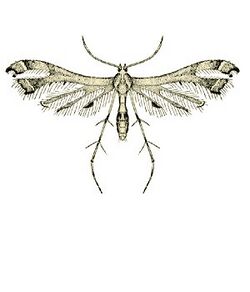Biology:Lantanophaga pusillidactyla
| Lantana plume moth | |
|---|---|

| |
| Scientific classification | |
| Domain: | Eukaryota |
| Kingdom: | Animalia |
| Phylum: | Arthropoda |
| Class: | Insecta |
| Order: | Lepidoptera |
| Family: | Pterophoridae |
| Genus: | Lantanophaga |
| Species: | L. pusillidactyla
|
| Binomial name | |
| Lantanophaga pusillidactyla (Walker, 1864)
| |
| Synonyms | |
| |
Lantanophaga pusillidactyla, the lantana plume moth, is a moth of the family Pterophoridae. It is native to the southern United States, Mexico, the Caribbean, and South America. It was introduced to Australia accidentally in 1936 and is now found from Sydney to Cairns along the coast. It has also been introduced to Hawaii in 1902, Pohnpei in 1948, and Palau in 1960 for biological control. It has since been recorded from Yap in 1987–1988 and is now distributed on all islands of the Mariana and Caroline Islands where the host plant is found, except Aguijan.
Other records include Cape Verde, Republic of the Congo, Democratic Republic of the Congo, Ivory Coast, Réunion, South Africa , Madagascar , Mauritius, Nigeria, Seychelles, Eswatini, Tanzania, Zambia, Israel, Morocco, India , Indonesia (Java), New Guinea and Sri Lanka.[3]
The wingspan is 11–14 mm.
Adults feed on flowers and lay eggs in flower heads. The larvae feed on Lantana camara, Lantana montevidensis, Lantana hispida, Lantana peduncularis, Lantana indica, Lantana involucrata, Lippia alba, Phyla nodiflora, Phyla lanceolata, Caperonia palustris, Mentha and Utricularia species. They feed inside flowers or tunnel around the base of the flower. They feed for seven to ten days and pupate in the flower clusters. The development time from egg to adult is about fourteen days.
References
- ↑ Busck, August (1914). "New Microlepidoptera from Hawaii". Insecutor Inscitiae Menstruus 2 (7): 103–104. https://www.biodiversitylibrary.org/page/9141294.
- ↑ On the fauna of the plume moths (Lepidoptera, Pterophoridae) of KwaZulu Natal province (South-African Republic)
- ↑ De Prins, J.; De Prins, W. (2017). "Lantanophaga pusillidactylus (Walker, 1864)". http://www.afromoths.net/species_by_code/LANTPUSI. Retrieved November 18, 2017.
External links
| Wikimedia Commons has media related to Lantanophaga pusillidactyla. |
- Australian Faunal Directory
- Trin Wiki
- Fact Sheet
- Hollenbeck, Jeff (August 26, 2007). "Species Lantanophaga pusillidactyla - Lantana plume moth - Hodges#6119". http://bugguide.net/node/view/140271.
- Insects of Micronesia Lepidoptera: Pterophoridae
- Gielis, C. (2006). "Review of the Neotropical species of the family Pterophoridae, part I: Ochyroticinae, Deuterocopinae, Pterophorinae (Platyptiliini, Exelastini, Oxyptilini) (Lepidoptera)". Zoologische Mededelingen Leiden 80-2 (1). http://repository.naturalis.nl/document/41270.
Wikidata ☰ Q5948575 entry
 |

